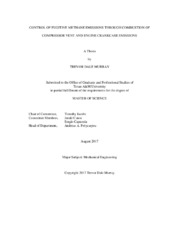| dc.description.abstract | At compressor stations, fugitive methane emissions from compressor piston rod packing and engine crankcases are vented directly into the atmosphere. In an effort to reduce compression station carbon footprint, this study evaluates the feasibility of combusting the methane emissions into carbon dioxide and thus reduce the global warming potential. This study focuses on running simulations to determine the methane reduction from rebreathing engine crankcase and compressor vent gases into the air intake of a large bore, natural gas, 2-stroke engine. The methane reduction percentage is observed over a range of rebreathed gas mass flow rates, and rebreathed gas composition.
It is extremely difficult to determine the composition of the engine blow-by gases in the crankcase, since the composition depends on a large variety of parameters. For this study, the emissions from the compressor was modeled as methane, and the emissions from the engine crankcase was modeled as products of combustion with a varying amount of methane concentrations. A sensitivity analysis was performed, and the observed pressure traces show that the engine performance is not affected by the addition of rebreathed gases. This insensitivity mainly results from the very small rebreathed flow rates compared to the air intake, and the adjustments made on engine parameters, boost pressure and fuel injection rate, to keep TER and the energy delivery rate the same.
The simulations also showed that the net methane reduction percentage was approximately 52%, no matter the study test conditions. It was discovered that the methane reduction depends on the trapping ratio of the engine; since these engines generally have trapping ratios around 50%, the actual methane reduction tends to be small. A 52% reduction rate is not desirable; the hope is to increase the reduction rate closer to 100%. More importantly to note, a substantial amount of complexity would need to be added to a typical compressor station just to reduce methane emissions by 1 kg/hr. Thus, at present, the idea of rebreathing compressor and engine crank case gases for methane emission reduction is not feasible. Future studies should focus on routing the emissions to a 4-stroke engine, a waste heat recovery system, or other combustion devices with higher trapping ratios. | en |


